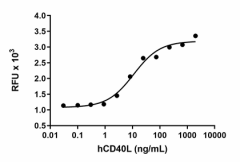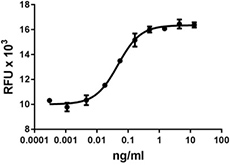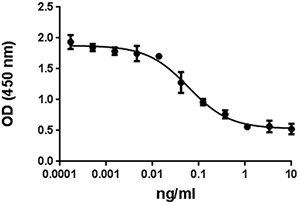- Regulatory Status
- RUO
- Other Names
- CD154, TNF-related activator protein (TRAP), GP39, TNFSF5
- Ave. Rating
- Submit a Review
- Product Citations
- publications

-

Human CD40L induced the proliferation of human B cells in the presence of IL-4 in a dose-dependent manner. The ED50 for this effect is 6 – 36 ng/mL.
CD40L is a type II membrane protein that shares 78% amino acid identity with its mouse counterpart. Human CD40L is a polypeptide of 261 amino acids, consisting of 22, 24, and 215 amino acids for the cytoplasmic, transmembrane, and extracellular domains respectively. Soluble forms of CD40L (sCD40L) have been identified, and a 18 kD fragment has the ability to form homotrimers and bind to CD40 to induce biological signals. The 18 kD protein has full activity in B cell proliferation and differentiation assays. Activated platelets express CD40L on their surface and constitute the major source of sCD40L (>95% in blood). Platelet-derived CD40L regulates neutrophil recruitment and lung damage in sepsis, and it has been suggested that MMP9 regulates CD40L shedding in abdominal sepsis. Platelet-associated CD40L has been linked to progression of atherosclerotic disease, and elevated plasma levels of sCD40L in patients seems to be a reliable predictor of cardiovascular events, such as atherosclerotic plaque rupture and acute coronary syndromes. Also, platelet-associated CD40L expression is increased in idiopathic thrombocytopenic purpura patients, and it has been speculated that platelet-associated-CD40L drives the activation of autoreactive B lymphocytes in this disease. In addition, high plasma levels of sCD40L have been connected to HIV-Associated Neurocognitive Disorders (HAND).
Product DetailsProduct Details
- Source
- Human CD40L, amino acids Glu108-Leu261 (Accession# NM_000074.2) was expressed in 293E cells. The N-terminal contains 9His-2(SGGG)-IEGR-tag.
- Molecular Mass
- The 175 amino acid recombinant protein has a predicted molecular mass of approximately 19 kD. The DTT-reduced and non-reduced protein migrate at approximately 25 kD by SDS-PAGE. The N-terminal amino acid contains 9His-2(SGGG)-IEGR-tag.
- Purity
- >95%, as determined by Coomassie stained SDS-PAGE.
- Formulation
- 0.22 µm filtered protein solution is in PBS.
- Endotoxin Level
- Less than 0.01 ng per µg cytokine as determined by the LAL method.
- Concentration
- 10 and 25 µg sizes are bottled at 200 µg/mL. 100 µg size and larger sizes are lot-specific and bottled at the concentration indicated on the vial. To obtain lot-specific concentration and expiration, please enter the lot number in our Certificate of Analysis online tool.
- Storage & Handling
- Unopened vial can be stored between 2°C and 8°C for up to 2 weeks, at -20°C for up to six months, or at -70°C or colder until the expiration date. For maximum results, quick spin vial prior to opening. The protein can be aliquoted and stored at -20°C or colder. Stock solutions can also be prepared at 50 - 100 µg/mL in appropriate sterile buffer, carrier protein such as 0.2 - 1% BSA or HSA can be added when preparing the stock solution. Aliquots can be stored between 2°C and 8°C for up to one week and stored at -20°C or colder for up to 3 months. Avoid repeated freeze/thaw cycles.
- Activity
- Human CD40L induced the proliferation of human B cells in the presence of IL-4 in a dose-dependent manner. The ED50 for this effect is 6 – 36 ng/mL.
- Application
-
Bioassay
- Application Notes
-
BioLegend carrier-free recombinant proteins provided in liquid format are shipped on blue-ice. Our comparison testing data indicates that when handled and stored as recommended, the liquid format has equal or better stability and shelf-life compared to commercially available lyophilized proteins after reconstitution. Our liquid proteins are verified in-house to maintain activity after shipping on blue ice and are backed by our 100% satisfaction guarantee. If you have any concerns, contact us at tech@biolegend.com.
- Product Citations
-
Antigen Details
- Structure
- Homotrimer
- Distribution
-
T cells, basophils, mast cells, activated platelets
- Function
- CD40L induces proliferation, differentiation, and immunoglobulin class switching in B cells; also prevents apoptosis in B cell. CD40L is induce in T cells after in vitro activation with PHA, PMA plus ionomycin, anti-CD3, anti-CD2, and CD28 engagement in anti-CD3 activation. Also, CD40L is induced by thrombin in platelets.
- Interaction
- B cells, neutrophils, follicular dendritic cells, dendritic cells, macrophages, epithelial cells, epithelial carcinoma cells, endothelial cells, smooth muscle cells, fibroblasts, hepatic stellate cells, and glomerular mesangial cells
- Ligand/Receptor
- CD40
- Biology Area
- Cell Biology, Costimulatory Molecules
- Molecular Family
- Cytokines/Chemokines, Growth Factors, Immune Checkpoint Receptors
- Antigen References
-
1. Spriggs MK, et al. 1992. J. Exp. Med. 176:1543.
2. Mazzei GJ, et al. 1995. J. Biol. Chem. 270:7025.
3. Delmas Y, et al. 2005. Med. Sci. (Paris) 21:825.
4. Meabed MH, et al. 2007. Haematology 12:301.
5. Sprangue DL, et al. 2008. Blood 111:5028.
6. Davidson DC, et al. 2012. PLoS One 7:e51793.
7. Rahman M, et al. 2013. J. Thromb. Haemost 11:1385. - Gene ID
- 959 View all products for this Gene ID
- UniProt
- View information about CD40L on UniProt.org
Related FAQs
- Why choose BioLegend recombinant proteins?
-
• Each lot of product is quality-tested for bioactivity as indicated on the data sheet.
• Greater than 95% Purity or higher, tested on every lot of product.
• 100% Satisfaction Guarantee for quality performance, stability, and consistency.
• Ready-to-use liquid format saves time and reduces challenges associated with reconstitution.
• Bulk and customization available. Contact us.
• Learn more about our Recombinant Proteins. - How does the activity of your recombinant proteins compare to competitors?
-
We quality control each and every lot of recombinant protein. Not only do we check its bioactivity, but we also compare it against other commercially available recombinant proteins. We make sure each recombinant protein’s activity is at least as good as or better than the competition’s. In order to provide you with the best possible product, we ensure that our testing process is rigorous and thorough. If you’re curious and eager to make the switch to BioLegend recombinants, contact your sales representative today!
- What is the specific activity or ED50 of my recombinant protein?
-
The specific activity range of the protein is indicated on the product datasheets. Because the exact activity values on a per unit basis can largely fluctuate depending on a number of factors, including the nature of the assay, cell density, age of cells/passage number, culture media used, and end user technique, the specific activity is best defined as a range and we guarantee the specific activity of all our lots will be within the range indicated on the datasheet. Please note this only applies to recombinants labeled for use in bioassays. ELISA standard recombinant proteins are not recommended for bioassay usage as they are not tested for these applications.
- Have your recombinants been tested for stability?
-
Our testing shows that the recombinant proteins are able to withstand room temperature for a week without losing activity. In addition the recombinant proteins were also found to withstand four cycles of freeze and thaw without losing activity.
- Does specific activity of a recombinant protein vary between lots?
-
Specific activity will vary for each lot and for the type of experiment that is done to validate it, but all passed lots will have activity within the established ED50 range for the product and we guarantee that our products will have lot-to-lot consistency. Please conduct an experiment-specific validation to find the optimal ED50 for your system.
- How do you convert activity as an ED50 in ng/ml to a specific activity in Units/mg?
-
Use formula Specific activity (Units/mg) = 10^6/ ED50 (ng/mL)
 Login / Register
Login / Register 















Follow Us